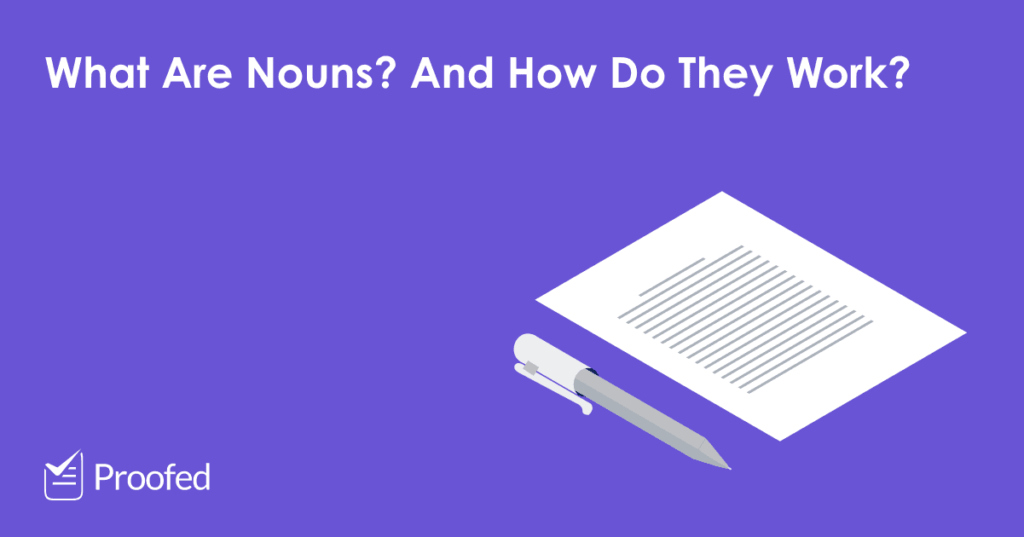Nouns are a key element of language. But what exactly is a noun? Here, we’ll explain the basics of nouns in English and some common noun types.
What Is a Noun?
Nouns are naming words. This means we use them to name people, animals, places, objects, and ideas. Examples of nouns include:
- People nouns – man, woman, doctor, chef, Lucy, Howard
- Place nouns – school, home, city, park, Europe, China
- Other nouns – cat, fish, bicycle, toaster, happiness, love, money
Nouns are often the subject or object in a sentence. For example:
Simon kicked the ball.
Here, “Simon” is a noun and the subject of the sentence (i.e., it names the person carrying out the action in the sentence). And the noun “ball” is the object of the sentence (i.e., it names the thing Simon is acting on).
Nouns can play other roles in English (e.g., modifying another word). However, most of the time, they name things in a sentence.
Different Types of Nouns
We can also divide nouns into different types, including:
- Proper and common nouns
- Concrete and abstract nouns
- Countable and uncountable nouns
- Collective nouns
- Noun phrases
It’s worth noting here that all nouns belong to more than one class. For example, “kindness” is a common, abstract, uncountable noun, whereas “Napoleon” is a concrete, proper, countable noun. But it helps to know these categories, as English sometimes has special rules for different noun types.
We’ll look briefly at all the above in the rest of this post.
1. Proper and Common Nouns
All nouns can be divided into proper and common nouns:
- Proper nouns name unique people, places, organizations, and things. These words always begin with a capital letter.
- Common nouns name generic things. Unlike proper nouns, these usually only begin with a capital letter at the start of a sentence.
For example, “person” is a common noun since it refers to a generic thing. But “Duncan” is a proper noun since it names a specific person. You can see the difference between more proper and common nouns in the table below.
|
Proper Nouns |
Common Nouns |
|
Brazil |
country |
|
New York |
city |
|
October |
month |
|
Garfield |
cat |
|
Microsoft |
company |
2. Concrete and Abstract Nouns
We can also divide nouns into concrete and abstract nouns:
Find this useful?
Subscribe to our newsletter and get writing tips from our editors straight to your inbox.
- Concrete nouns are things you can see, hear, smell, taste, or touch, such as “coffee,” “child,” “bed,” “water,” and “sunlight.”
- Abstract nouns are things you cannot perceive with your senses, including ideas and emotions like “anger,” “knowledge,” and “truth.”
Despite this, we treat abstract and concrete nouns the same in writing.
3. Countable and Uncountable Nouns
Another way of classifying nouns is as countable or uncountable:
- Countable (or count) nouns refer to things you can count. They can be singular or plural. Examples include “day,” “train,” “chair,” and “coin.”
- Uncountable (also non-count or mass) nouns describe things you cannot count as individuals. They are always singular. Examples include “patience,” “rice,” “money,” “work,” and “music.”
For example, “rabbit” is countable as you can count rabbits individually (e.g., “seven rabbits”). But “water” is uncountable as we can’t divide a quantity of water into individual “waters.” Thus, we have to say how much, not how many, of an uncountable noun we mean (e.g., “a gallon of water”).
4. Collective Nouns
Collective nouns name a group, such as “family,” “crew,” and “team.” People usually treat these group nouns as singular, especially in US English:
The team is celebrating its win.
But you can use plural terms with collective nouns when referring to the members of a group acting individually:
The team are arguing with one another.
Here, we use the plural verb “are” because we’re describing the members of the team arguing among themselves, not acting together as a group.
5. Noun Phrases
Finally, a noun phrase is a phrase that plays the role of a noun. This will always include a noun, but it will also include other words that tell us about the main noun. It could be just two words (i.e., a noun and a modifier):
My brother is going home tomorrow.
Here, for instance, the modifier “my” tells us about the noun “brother.” But noun phrases can be more complex and made up of several words:
I took the bus that was supposed to arrive this morning.
The main noun here is “bus.” But this is modified by “that was supposed to arrive this morning,” which tells us the specific bus the speaker has in mind.
Expert Proofreading
We hope this has clarified the basics of nouns in English for you! For more grammar tips, check out our Common ESL Writing Errors guide. If you would like a little help to check any aspect of your writing, though, why not try our expert proofreading services for free today?



